Been Enjoying Banksy's London Safari
...but who benefits from those street art pieces, in the end?
Ciao,
how are you?
I’m writing to you again from London, where I’m spending the summer reconnecting with the roots of my BLocal project—a 13-year editorial journey focused on discovering cities from a local perspective.
The month began with the unveiling of Banksy's London Zoo series, which turned into an exciting treasure hunt across the city. I captured the adventure in these two vlogs:
Banksy’s London Zoo - Part 1 🤩 (my favorite one!) 🤩
Banksy’s London Zoo - Part 2
Soon after, I had the pleasure of welcoming some of you to the city I'm temporarily calling home. I designed five unique urban walks to explore London together, and the experience was as enriching as our urban adventures in Paris and Madrid earlier this year.
Over five intense days, we walked from morning till evening, exploring every corner of the city—from its hidden suburbs to its rapidly changing neighborhoods. We shared our thoughts on the sights we encountered, discussed the artworks that resonated with us, and marveled at how drastically the city can transform just by crossing a street.
Urban art became our lens for understanding London, but we also delved into our personal experiences, comparing our stories from home and on the road, uncovering both the differences and the common threads.
We reflected on how each of us remembered London from previous visits and observed how the city has evolved, aware that we were capturing only a fleeting snapshot of a place in constant flux. The cranes dotting the skyline were a constant reminder of the city's ever-changing nature, where entire neighborhoods can be transformed overnight, and street art is often replaced within hours.
I tried to encapsulate London’s endless variety in our walks, but there’s still so much more to explore as I continue writing my upcoming book on London street art. Even in this early stage, this book project has already given me so much. Sharing the research process behind it with some of you was particularly rewarding. Knowing that when you flip through its pages, you’ll recall the curry we shared, the wind on the rooftop where we captured London’s skyline, or the frustration of a car blocking our view of an artwork—this adds layers of meaning to the work.
For me, exploring a city with you is like seeing my work in 3D, with you adding the depth through your stories and observations. This exchange and connection have been incredibly fulfilling—something I’ve missed during years of blogging and online work. I’m thrilled to have found a way to make it all more real and tangible, and I’m already looking forward to our next adventure together.
Until next month,
Giulia
P.S. You might hear from me sooner, though—there’s a good chance The Paris Book will be ready for pre-orders in September, and I can’t wait to share the news with you! 😉
P.P.S. The dates for the Athens trip have changed. The new dates are October 18-21—more details below, right after the Banksy editorial.
Who Owns Street Art?
On street art ownership, commodification, and the ethics of preserving or selling works that were intended for public spaces.
As soon as I landed in London, I was swept up in something extraordinary—the sudden appearance of new Banksy pieces scattered across the city. Each day, a fresh work emerged, greeted by a mix of awe, curiosity, and the playful thrill of a treasure hunt. But as I stood there, witnessing this unfold for the first time, a critical question began to take shape in my mind, one that I had never deeply contemplated before: What happens next?
🐐 Banksy’s London Zoo as a Case Study
This experience with Banksy’s London Zoo series turned out to be a fascinating case study, not just of street art itself, but of the complex issues surrounding its ownership and preservation.
Each piece in this series met a different fate, determined largely by the type of surface it was painted on and who legally owned that surface. As I watched these events unfold, it became increasingly clear that the destiny of each piece wasn’t just about art—it was about power, control, and who gets to decide the future of something that had instantly become a public treasure.
Some works were quickly removed, either by property owners or by thieves, both groups motivated by profit. Others were preserved, seen as cultural artifacts worth protecting. But this raises an important question: Is this how the art was intended to be experienced? Or does preserving street art, which inherently embraces ephemerality, contradict the very nature of the art form itself—a form defined by its defiance of permanence?
Moreover, this unfolding of events highlighted a broader uncertainty surrounding street art: who truly owns it? Is it the property owner, who legally controls the wall it’s on? The public, who often feel a sense of communal ownership over these works? Or the artist, whose intent was to gift the art to the public space, not to see it locked away or sold?
🐘 Before you read on, take a moment to share your initial thoughts in a comment. As you continue, feel free to add another comment if any new ideas emerge. (And if you’re unsure how to comment on Substack posts, you can always just reply to this email.) 🐘
🙉 These questions aren’t just theoretical—they’ve played out in real time for me over the past month in London. Yet, the story isn’t new; it’s a narrative that has repeated itself in different forms, as highlighted in the documentary "The Man Who Stole Banksy" (2018).
This film chronicles the journey of a Banksy mural removed from the separation wall in Bethlehem. The mural’s removal and eventual sale on the art market raise ethical dilemmas that closely mirror the fate of the London Zoo pieces. Is it right to commodify art that was created to provoke thought in its original location? And when street art is sold, who truly benefits—the artist, the community, or the individual who controls the surface it was painted on?
🙈 A similar dilemma is brought to light in "Banksy and the Stolen Girl" (2023) which tells the story of the theft of Banksy’s Bataclan mural, "The Sad Girl."
Painted as a tribute to the victims of the 2015 Paris attacks, this mural was stolen, igniting a legal battle over its rightful ownership. Like the London Zoo pieces, this story underscores the complexities surrounding street art ownership. Who has the right to control a piece of art created in public, often without permission, but that has since gained significant cultural meaning?
🙊 Whether a piece is preserved, destroyed, commodified, or left to fade into the urban landscape hinges on a tangled web of ownership, intent, and public perception. And as I’ve witnessed this past month in London, the story of street art is far from simple—it’s a story of power, of who gets to decide what happens next.
🐺 Street Art and Copyright Law
Street art, by its very definition, is usually created in public spaces without permission—often illegally—challenging traditional notions of ownership and legal rights.
While copyright law is designed to protect an artist’s work from unauthorized use, applying these protections to street art raises a host of questions and complications, particularly when it comes to enforcing copyright in situations where the artwork was not intended for private ownership but was instead created as a “collective treasure.”
🐈 Street art occupies a complex legal gray area. On one hand, like any other creator in any other artistic field, street artists should have the right to control how their work is used. Copyright law traditionally protects these rights, allowing artists to maintain control over their creations. However, street art fundamentally challenges these conventional notions of property and ownership. Unlike other art forms, street art is often viewed as a form of public dialogue—a contribution to the urban landscape that is inherently tied to its location and context.
This public nature of street art complicates the question of ownership. Many street artists themselves acknowledge this complexity; they often say that as soon as they apply the first drop of paint, the artwork ceases to belong to them—it belongs to the street, to the public. In this sense, street art is considered a gift to the community, something meant to be shared and experienced collectively rather than owned or controlled by any single entity.
🐠 However, this perspective clashes with legal realities, particularly when works by famous artists like Banksy are appropriated for commercial use or removed from their original locations to be sold.
🐠 Moreover, this situation raises ethical questions about the commodification of art that was intended to remain in its original context, provoking thought or serving as a communal gift rather than being transformed into a private commodity.
🐠 This leads us to question who truly benefits from street art—is it the artist, the community, or the individual who controls the physical surface on which the art was created?
🦏 The tension between street art’s rebellious, ephemeral spirit and the desire to protect it as civic property—owned by the community rather than individuals—highlights the limitations of current copyright laws. These laws were designed for permanent art forms, not for works meant to engage with public spaces, provoke thought, and sometimes fade away.
How can the integrity of these works be protected when they were never meant to last, and when their very creation often defies legal norms?
🦍 Conclusion
Legal adaptations are essential to acknowledge the public and often temporary nature of street art while ensuring these works remain accessible to the communities they were created for.
This evolution in law must strike a balance between protecting artists' rights and preserving the transient essence that defines street art, as the impermanence of street art is central to its identity and impact.
Attempts to preserve street art, while well-meaning, can strip it of its essential context and meaning. These works are meant to exist in public spaces, experienced in their intended settings, and often allowed to fade naturally. By removing or commodifying these pieces, we risk undermining the very qualities that make street art compelling: its transience, its dialogue with the urban landscape, and its role as a fleeting yet powerful form of public expression.
Explore ATHENS with me!
(Last Trip Together in 2024)
⚠️ Heads up! ⚠️ The dates for the Athens trip have been updated. The new dates are October 18-21.
I’m taking an extra week to work really hard on the itinerary for our final trip of 2024—I want to make it truly special!
If you're thinking about joining me in Athens, now’s the time to book! The Early Bird offer ends on September 23rd, so don't miss out. A detailed program will be available online by September 27th.
For more information or to reserve your spot, just send me an email (or reply to this newsletter) and I’ll be happy to share all the details with you!
✍️ NEW on the Blog!
Rewilding the City Through Banksy’s London Zoo: Ownership, Removal, and the Fight for Street Art’s Freedom.
In this article, I’m delving deeper into Banksy’s London Zoo street art series, exploring the meaning of it, sharing insights on what happens when a new Banksy artwork is unveiled, and offering some thoughts on the ongoing debate about who owns the right to display—or displace—these pieces.
Exploring Penge Street Art: From Streets to Rooftop Murals.
This is the first of many articles on London’s best street art projects. Let’s begin our exploration in Penge, a suburb in the southeast.
📽️ NEW on YouTube!
🔔 Don't forget to subscribe to my YouTube channel and hit the bell to get notified whenever there's something new—since I won't be posting on a regular schedule!
🫶 Readers’ Survey
It's been a while since I last shared a reader survey, and with so many new readers joining this newsletter (thank you!), I want to make sure I'm delivering content that truly matters to you. Plus, you can help decide the 2025 destination trips! Please take a moment to complete the survey and help shape a newsletter that’s worth your time.
📰 Stuff I Write When I’m Not Here
I rely on the support of readers like you to keep creating genuine and informative content. If you value my work and would like to see more of it, please consider making a donation to support my writing and my editorial project BLocal.
You can Buy me Pizzas or Donate via Paypal.
If you are currently unable to make a donation but find this newsletter and my street art travel guides in general interesting, you can help grow this community by forwarding this email to anyone you like, or sharing this publication on your social channels.





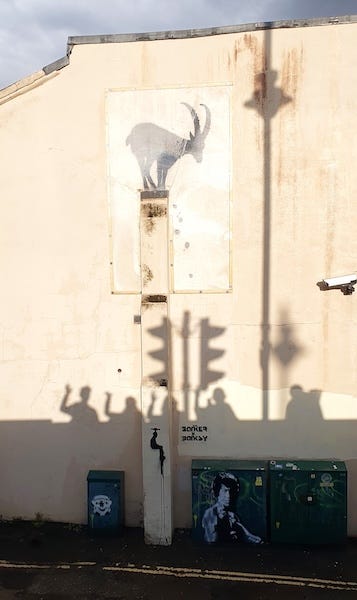
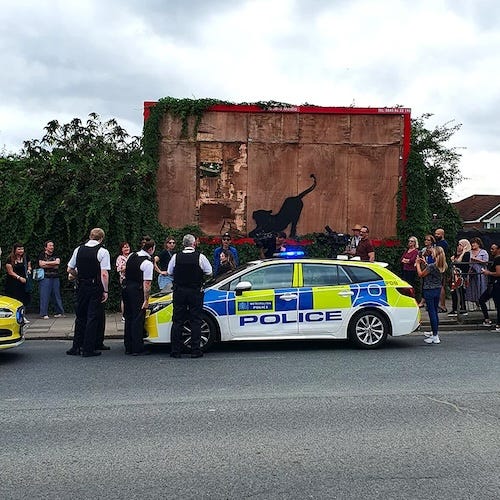
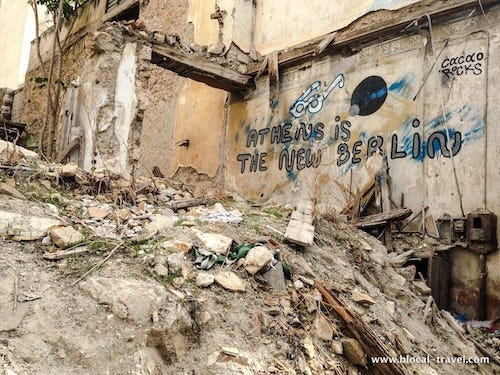
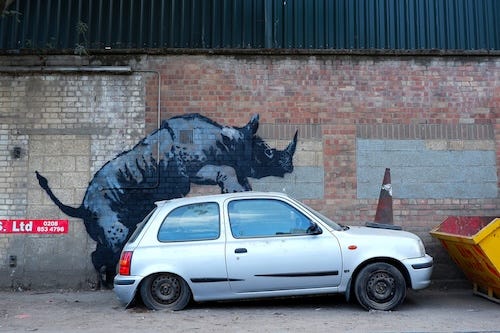
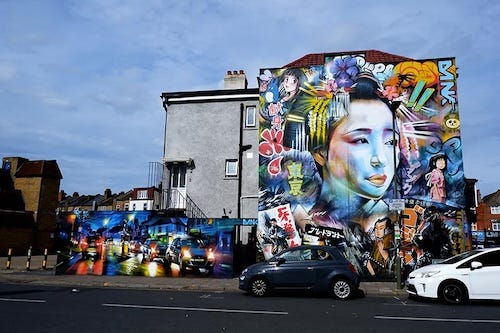
The reflection on: “Who Owns Street Art?” is very interesting. and in particular how it can be protected by copyright which has been opposed by Street artists, including Banksy who said: “Copyright is for losers”; thereby highlighting the nature of Street Art, characterized by gratuitousness and transience as well as by artistic contaminations.
The matter is regulated in Italy by a very ancient law (Law no. 633 of 22 April 1941) which has undergone various changes over time, most recently in 2023, and which -thanks to the Bern Convention for the protection of literary and artistic works of 1986- extended protection also to street works, including them among works of figurative art, regardless of their ephemeral nature, as long as they are "creative" and, therefore, expressive of the free choices and personality of the Author.
There is then a fundamental distinction between Street art 'commissioned' by a public or private entity for political-cultural, commercial or collecting purposes, and 'independent' Street art, where the creation, often of civil commitment, is created by the Artist illegally.
In the case of authorized works of urban art, the ownership right on the work, unless otherwise contractually agreed, will belong to the owner of the support, by virtue of the principle of accession provided for by the art. 936 of the civil code. The phenomenon of accession determines that a work created by a third party, with its own materials, is incorporated into the immovable property on which it stands, falling within the sphere of dominion of the owner of the material support.
Despite this, works are protected by copyright from the moment of creation. The rights remain with the artist, unless their transfer is expressly agreed. In any case, the transfer can never concern his moral rights, i.e. the rights of paternity and integrity of the work. If the patrimonial rights of the author last up to 70 years after the death of the Artist and can be transferred, the same cannot be said for the moral rights of the author, which are perpetual, non-transferable and inalienable.
In consideration of the above, I would believe that in Italy the use for commercial purposes by the owner of the medium or third parties is not free, being subject to the necessary prior approval of the Artist. The latter, in order to protect his moral right to the integrity of the work, has the right to oppose any modification and any prejudicial act of the work that damages his honor or reputation (art. 20, paragraph 1st, Copyright Law).
As regards independent urban art works, i.e. those created in the absence of authorization from the owners of the material supports whose dominion right over the property is compressed, precisely in light of the Berne Convention of 1986 (applicable in Italy), I would consider the illicit nature of the work irrelevant for the purposes of protecting the Author, so that the owner of the support also assumes the right of ownership of the work, and the artist is recognized as having copyright.
The italian civil Court of Cassation expressed it this way: "The work of genius can be excellent or very bad, educational or corrupting, or even decisive for egregious or criminal actions and can consequently bring its author fame or ridicule, wealth or misery. , and open to him the paths of the highest honors, or the doors of prison. But the work of the mind, whatever it may be, sublime or not, will always remain the inviolable property of the author".
The legal discipline that reconstructs the relationship between the author of the work created in an illicit form and the owner of the support must be referred to the aforementioned art. 936 civil code, pursuant to which the owner can keep the work incorporated into the support by paying a fee to the artist, or can remove the work within six months of becoming aware of the incorporation. As a result of the balance between the two constitutional rights at stake, such as the right to ownership of the property (art. 42 of the Constitution) and copyright (art. 33 of the Constitution), on a practical level that of the owner, being able to dispose of the work and exercise the rights deriving from accession over it.
In the event that the work is removed and detached from the support used or moved from the place of creation, discretionally chosen by the artists, there is an infringement of the right to the integrity of the work when such acts lead to a substantial modification of the message artistic originally underlying the work, damaging the honor or reputation of the artists.
Street artists who hide their real identity behind anonymity or a pseudonym do not incur a deprivation or limitation of legal protection, being able, at any time, to claim paternity of the work (art. 20 Copyright Law), and to exercise the copyright rights connected thereto.
Banksy, for example, manages the rights of economic use on his works through Pest Control Office Ltd, the English company founded by the artist himself in order to protect his works from abusive exploitation. As stated on the company website: “Pest Control Office is the only official body that can authenticate a genuine artwork by Banksy. We do this to prevent confusion, fraud and misattribution”.
And, again: “Anybody is free to use Banksy’s images for non-commercial and personal amusement. Print them out in a color that matches your curtains, make a card for your gran, submit them as your own homework, whatever. But neither Banksy nor Pest Control Office license the artist’s images to third parties. Nobody can use Banksy’s images for any commercial purpose, including launching a range of merchandise or tricking people into thinking something is made or endorsed by the artist when it isn’t. Saying Banksy wrote ‘copyright is for losers’ in his book doesn’t give you free rein to misrepresent the artist and commit fraud. We checked”.
On the basis of these regulatory indications, it is clear that the works of "masked" artists are protected in Italy by copyright in the event of violations provided that they, through valid representatives, retain the right to legitimately bring legal action against third-party users. unauthorized and without having to give up their secret identity.
This quick (and summary) overview of Italian law confirms, if possible, the absolute need to adapt the legislation to the innovations introduced by Street Art, in particular with regard to the "right of the community" to maintain the work; a right that is not protected at all today even if it is precisely what the Street Artist presumably aimed at.
Riccardo – Italian lawyer
Great article! Just watched the documentary on Banksy. Really intriguing work!